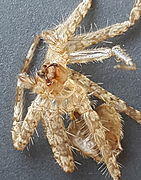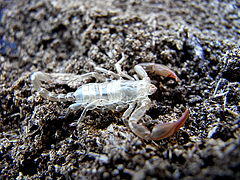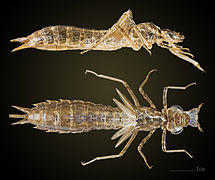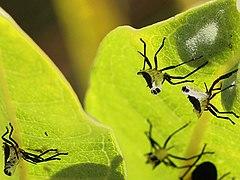In biology, exuviae are the remains of an exoskeleton and related structures that are left after ecdysozoans (including insects, crustaceans and arachnids) have moulted. The exuviae of an animal can be important to biologists as they can often be used to identify the species of the animal and even its sex.
As it is not always practical to study insects, crustaceans or arachnids directly and because exuviae can be collected fairly easily, they can play an important part in helping to determine some general aspects of a species' overall life cycle such as distribution, sex ratio, production and proof of breeding in a habitat.
The Latin word exuviae,[1] meaning "things stripped from a body", is found only in the plural.[2] Exuvia is a derived singular usage that is becoming more common, but in fact this is incorrect. Only a single historical work by Propertius uses the term Exuvium as a singular form,[3] and a few modern works (e.g.[4]).
Gallery
References
- ^ "Charlton T. Lewis, An Elementary Latin Dictionary, exuviae". Retrieved July 25, 2016.
- ^ "Exuviae". Lewis and Short Latin Lexicon. The Archimedes Project. Retrieved 21 September 2014.
- ^ "Charlton T. Lewis, An Elementary Latin Dictionary, exuvium". Retrieved July 25, 2016.
- ^ "The final instar exuvium of Pycna semiclara Germar, 1834 (Hemiptera: Cicadidae)" - John M. Midgley, Nicolette Bouwer and Martin H. Villet






